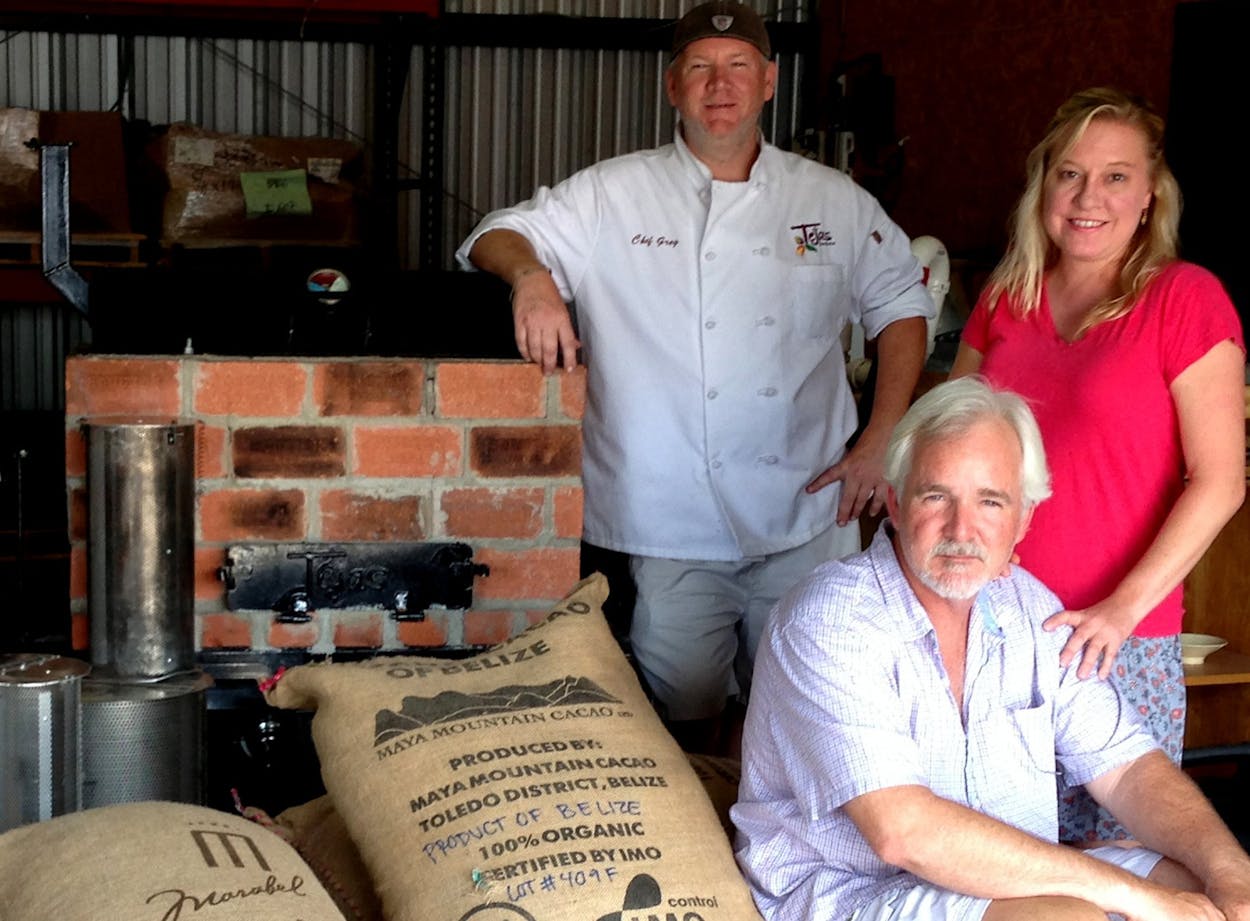DALLAS — “Texans will smoke anything,” said Scott Moore Jr., a Tejas Chocolate co-founder, explaining why his Papua New Guinea bars are one of his top sellers, to a roomful of hopeful chocolate makers at the annual Dallas Chocolate Festival last month. Another maker had just razzed him for playing up the smoke in his bars, something chocolate connoisseurs consider a defect of the Papua New Guinea bean.
Moore, 50, shrugged and then pointed a hair dryer into a big bowl full of cacao nibs and shells, to show how to winnow cacao beans at home without fancy machinery. “This is probably going to make a mess,” he said.
The white-goateed Texas native from Houston is one of about 100 bean-to-bar chocolate makers in the United States, and one of only a few in the Lone Star State. He founded his Houston company, Tejas Chocolate, in 2010 with business and life partner Michelle Holland. Three years later, their Capistrano bar, made with Madagascar beans, won a silver medal at the industry’s important International Chocolate Awards, and his products are sold at places like The Meadow, an exclusive chocolate store in Portland, Ore., and Specs, a liquor store that carries fine foods, in Houston .
One of the first steps of chocolate making is to dry the raw cacao beans. Because raw beans do not travel well, this typically happens in the country of origin, whether that is, for example, Ecuador or Papua New Guinea. Most people lay the beans out on a tarp or in the road, but in Papua New Guinea, it rains almost every day, so “they don’t have the luxury of putting the beans out in the sun to dry,” Moore said. Instead, Papua New Guineans typically dry the beans in wood fires, and the smoke seeps into them. “It’s almost like barbecuing cacao,” Moore said.
Many chocolate connoisseurs consider that smoke anathema, and some try to change the way Papua New Guineans dry their beans. For example, Amano Artisan Chocolate, based in Orem, Utah, educates Papua New Guinean farmers on sun drying and imports only beans that have not been smoked. As a result, their bars have grapefruit notes instead of smoky overtones. But in Texas, Moore said, “We’ll smoke a two-by-four and eat it if we have to.”
And that is the essence of Tejas’s chocolate bars. While other makers try to balance the beans’ acidity, bitterness and smoke, Moore plays up these qualities in his Papua New Guinea beans, which he roasts in a barbecue pit.
Dallas Chocolate Festival co-organizer Adrienne Newman (also known as Madame Cocoa) said the chocolate he turns out was strong, accessible and unique.
“Discover Chocolate” author Clay Gordon added, “If you like peaty single-malt scotch, you’ll like the smoked bars. In the hands of a master craftsman, the smokiness can be quite wonderful.”
Moore has only been making chocolate for four years, but according to Ms. Newman, he is on his way to becoming a master. Tejas Chocolate was the first in Texas to make chocolate starting with the beans. After watching a Food Network show about bean-to-bar chocolate a few years ago, Moore tried a Mast Brothers bar, from Brooklyn, N.Y., and was “blown away by how good it was.”
He found out that he could make chocolate relatively easily at home, bought some beans from chocolatealchemy.com and started roasting in his oven. After just two batches, he decided to roast in his barbecue pit, “because that’s what a good Texan would do.” He converted a peanut-roasting drum into a cacao-bean-roasting drum and never looked back.
When he officially opened the Tejas Chocolate shop in the spring of 2011, Moore built a big barbecue pit with reclaimed clay bricks. He roasts four metric tons of cacao beans a year, or 180 pounds of chocolate a week. He names the bars after old Spanish missions in Texas, like Ysleta, Concepción and Espada.
Moore only maintains a fire for part of the time. “The balance of the roasting cycle is carried out by the radiant heat of the bricks and lava rocks,” Moore said. “It’s the closest that I could get to roasting low and slow like you would when you barbecue.”
In the fledgling bean-to-bar world, there is no standard roasting temperature and time. Every maker does it differently. “That’s why you can give the same cocoa beans to me and 10 other makers and get different results,” Moore said.
Moore’s pit requires the beans to be roasted for longer, which can bring out unexpected flavors. Ecuadorean beans, for example, are known for their floral notes, but Tejas Chocolate’s barbecued Ecuadorean bars also taste fruity.
After the holidays, Moore is planning to move into a new space in Tomball and to build an open wood fire. He is interested in doing something reminiscent of the Mayans and Aztecs, who roasted in fire pits, a tradition that is still alive.
“You see ladies in South America roasting in a pan over an open fire,” Moore said, “and I want to do something similar.”






